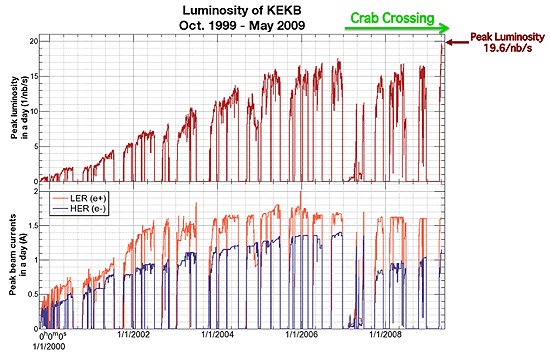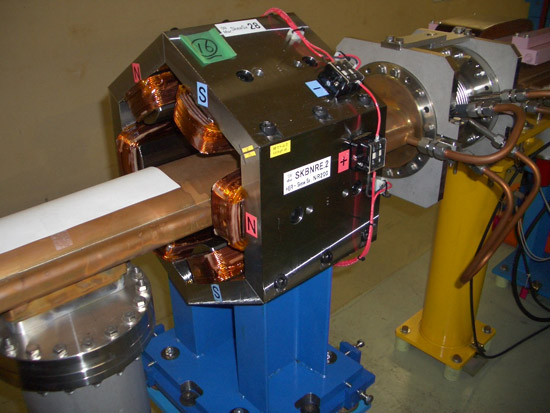A team of accelerator physicists at the KEK High Energy Physics Laboratory in Tsukuba, Japan, has broken the world's luminosity record by utilizing new accelerator devices called "crab cavities." The team at the KEKB electron-positron collider, home to the world's highest luminosity particle accelerator, installed the first pair of these futuristic superconducting radio-frequency cavities over two years ago.
Until 2007, the electron and positron bunches in the KEKB accelerator beams crossed at a 22 milliradian angle. The crossing angle itself has been one of the novel features of KEKB design, providing an effective beam separation after collision without a high detector background level, and it has been successfully used to achieve its world luminosity record. To boost the luminosity further, however, it was necessary to recover an effective head-on collision while retaining the crossing angle.
To accomplish this goal, the KEKB researchers built special superconducting radio-frequency (RF) cavities that kick each beam sideways in the horizontal plane so that the bunches collide head-on at the interaction point. These special RF cavities are called "crab cavities" and were first suggested almost 30 years ago by R. Palmer for linear electron-positron colliders. In 1989, K. Oide and K. Yokoya proposed the use of crab cavities in storage rings. This was followed by designs and prototype models of the crab cavity developed by K. Akai as a part of collaboration efforts between the KEK and Cornell laboratories around 1992. In the 1990s detailed engineering and prototyping were done at KEKB by K. Hosoyama's team, finally converging on the current design. The first full-size cavities were developed after intense discussion and elaboration and then installed in January 2007. The detailed commissioning of these novel devices at KEKB started in February 2007. Recently, a breakthrough was achieved by controlling the behaviour of off-energy beam particles with special skew sextupole magnets. On May 6, 2009, KEKB broke the world luminosity record and achieved a luminosity of 1.96 x 1034/cm2/sec using the crab cavities. This new record is almost a factor of two higher than the original design luminosity of KEKB. While this luminosity was being recorded, the background remained in good condition and the data were recorded smoothly in the Belle experiment.
The KEKB collider is used by researchers for the study of matter-antimatter asymmetry of bottom (beauty) quarks and searches for new physics at the Belle experiment, an international collaborative effort of scientists from universities and research institutes. Since the beginning of operation in 1999, the Belle experiment has reported a number of fundamental discoveries concerning matter-antimatter asymmetry and rare decays.
For the future, a super B Factory upgrade (called SuperKEKB) that will build on the experience and hardware developed at KEKB to achieve a luminosity higher by a factor of 40 is now being planned and designed in Japan. The recent breakthrough at KEKB and its long history of world luminosity records suggest that SuperKEKB will achieve its goals. A large international collaboration has also been formed to upgrade the Belle detector to observe the collisions at the SuperKEKB facility. The SuperKEKB machine has the potential to discover physics beyond the Standard Model in rare decays and unveil new kinds of matter-antimatter asymmetry.
| [ Media Contact ] |
Youhei Morita, KEK Public Relations Office
+81 29-879-6047
|
 |
| Figure 1 : History of KEKB luminosity increase. |
 |
| Figure 2 : Drawing of the KEK crab cavity. |
 |
| Figure 3 : Crab cavities tilt the electron and positron bunches so that they collide head-on at the interaction point. |
 |
| Figure 4 : Twenty eight skew sextupole magnets were recently installed in KEKB. |
|



